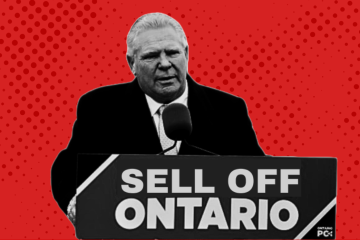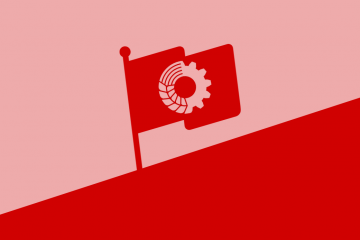CPC (Ontario) Provincial Committee Report – May 2020
Global crises of capitalism
Workers around the world are suffering from crises on several fronts: the immediate deadly pandemic, a deep economic crisis, and severe ecological devastation caused by the climate crisis.
In capitalist countries, including Canada, governments are unable to contain the health crisis and maintain corporate power and profits. The main strategy of these governments is to bail out the corporations and transfer immense wealth from working people to a faltering capitalist system, and to maintain control despite the ballooning numbers of unemployed workers, whether through use of the carrot or the stick.
The threat of war is exacerbated by the deepening systemic crisis triggered by the pandemic. The United States’ government has opportunistically strengthened regime change operations against countries like Iran, Cuba and Venezuela with increased sanctions and provocations. The new Cold War against China has escalated considerably. Ultra-right forces and capitalist governments have launched demonization campaigns which try to blame China as a way to divert attention from their own inaction and maintain the domination of US imperialism globally. In fact, China acted decisively to contain the virus in that country, helped the world by sharing the virus’ full genome sequencing with the international community on Jan 12, continues to offer material medical support and expertise to countries around the world and has offered to share a vaccine as soon as one is available.
The economic recovery envisioned by imperialism relies on militarism and war. The international situation during this crisis requires a clear class perspective – the main enemy is at home.
Ultra-right and fascist forces, who have been on the ascendancy since the last capitalist crisis in 2009, are also organizing to make use of the current situation. They fan the flames of anti-Chinese and anti-Asian racism, demand that workers be sacrificed to COVID-19 for the sake of profit and propagate conspiracy theories in order to shift the blame for people’s suffering away from the capitalist class. These ultra-right movements have leaders and expression in mainstream bourgeois politics – the Trump administration, Bolsanaro in Brazil, and MP Derek Sloan and others in the Conservative Party of Canada.
The pandemic
There is, as of yet, no vaccine. There is a vast under-supply of medical equipment, supplies, staff, and hospitals to stave off the spread of the disease. In Canada, while there are increasing calls, plans and now actual policies being implemented to “re-open”, there are not clear signs that COVID-19 is under control. Long-term care homes, homeless shelters, prisons and food processing plants are all making the news with outbreaks.
In general, the pandemic threatens everyone’s health around the world, with the most vulnerable being the elderly and the immunocompromised. But the health and economic impacts are not felt uniformly, despite repeated suggestions that “we’re all in this together.” The pandemic has an extremely disproportionate impact on the working class, who are more often forced to make decisions out of necessity that put them in harm’s way. This is especially true of the most marginalized members of the working class: Indigenous peoples, immigrant and racialized communities, women and the 2S/LGBTIQ community. These sections of the working class are “the last hired and first fired,” are most often subject to low wages and precarious work, and are forced to take risks that leave them exposed.
The systemic failures we are witnessing in our province and in other capitalist countries contrast with the efforts of China, Cuba, Vietnam and DPRK who have responded effectively to contain the virus. China and Cuba have sent doctors, medical teams and supplies around the world. China is making its experience in fighting the virus available to all and Cuba is offering anti-viral drugs it has developed to the world. Socialism has shown its ability to mobilize resources towards a common goal much more effectively than a system built to support private monopolies designed for profit.
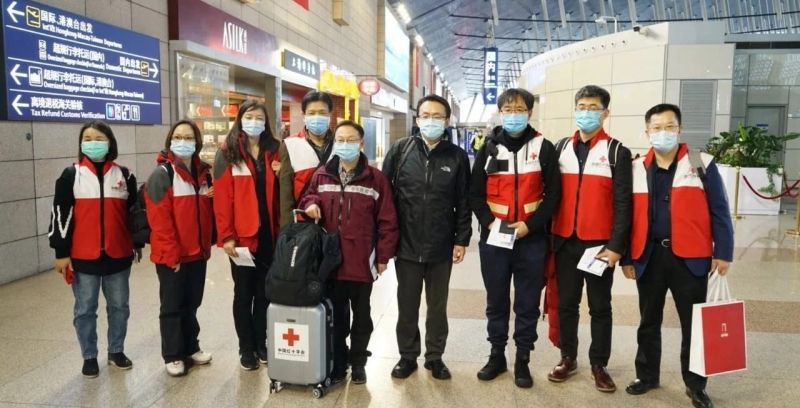

With the fragility of the capitalist system on full display due to the health and economic crises, the climate crisis has appeared less urgent to some. At this time where working people’s lives have been upended by the pandemic and governments’ inability to contain it, we should consider that the scientific projections for the effects on climate change are even more severe. In fact, those effects have already started to be felt with increased wildfires and flooding in Canada. The pandemic itself is being attributed to climate change by some scientists as animals lose habitat and come into more frequent contact with humans. Working people must fight back against the corporate drive to use new government emergency powers to evade environmental and carbon emission regulation. In Ontario, the Ford government dismantled protections under the province’s Environmental Bill of Rights (EBR) in April. Under the new regulation brought in with emergency powers, the government does not have consult on decisions that may have a significant effect on the environment, even if they are not related to COVID-19.
Urgent action on climate change cannot wait for a “return to normal”. As the oil and gas monopolies and other industries that are the main sources of carbon emissions are demanding even more state subsidies and bailouts, now is the time to transition to a publicly owned and delivered renewable energy industry.
The economic crisis
The pandemic has pulled the trigger on the capitalist economic crisis that was waiting in the wings. The way out of the last capitalist crisis paved the way for the current economic situation: massive corporate bailouts, record low interest rates, debt expansion, military spending, quantitative easing and massive corporate and wealth tax cuts. These ruling class policies restored profits and sent stocks higher but corporate and personal debt hit record levels.
The growing economic crisis will bring disaster for working people without immediate relief and efforts to implement a program to recover jobs, wages and living standards. The same prescription that was given to the financial system after 2008 will not create a healthy, sustainable economy. It will only further consolidate capital and personal wealth and push down living standards for the vast majority. Yet, by and large, the federal and provincial governments have followed the same “trickledown economics” script based on the philosophy that what’s good for business is good for workers.
This massive transfer of wealth can be seen in real time. A recent study from the Institute for Policy Studies in the U.S. demonstrated that billionaire wealth grew by 10 per cent between March 18th and April 10th of this year. Apart from the bailouts, corporations in some sectors, such as grocery stores, tech and e-commerce have seen massive profits from the pandemic. As the working class faces unemployment, pay cuts and are forced in many places to choose between their health and their livelihoods, the capitalist class, sheltered from exposure to the virus, are handed more and more wealth.
Government support payments have been allocated to corporate bailouts, with only piecemeal and short-term supports going to one-third of the workforce that is now unemployed in Canada. Federal Bill C-13 included $55 billion in deferred taxes, the largest part deferred corporate taxes. The other $52 billion in direct payments includes payments to the large national and transnational corporations “too big to fail”. An additional $15 billion bailout is being prepared for the oil and gas industry alone.
The relief directed towards working people is inadequate. Relief programs were rolled out with gaps adding confusion for people. One such program is the “Canada Emergency Response Benefit” (CERB), which the government claims will provide $2000 per month for 16 weeks to workers and self-employed individuals who are unemployed as a result of the pandemic. Regardless, the $2000 (taxable) payment is insufficient to cover the costs of housing, utilities, food and other necessities in almost any area of the country.
As details have slowly emerged about CERB, it is clear that many working people are excluded. A study by CCPA shows that a full one third of unemployed people (approx. 862,000 individuals) will receive nothing from either EI or CERB because of the eligibility criteria. One example is that those who were unemployed before COVID-19 will get nothing from CERB. In response to the outcry over these exclusions, the government has begun introducing other targeted programs. These include the Canadian Emergency Student Benefit (CESB), which provides a paltry $1250 per month to post-secondary students and recent graduates, payable between May and August.
Even these meager supports have come under attack from the Conservative Party and some corporate sectors. They are fighting to have the benefit curtailed and reduced in order to create an even larger pool of desperate and exploitable labour during the pandemic.
By the middle of May, eight million applications were received for CERB. This is a clear indication of the depth of economic precarity experienced by the working class, a depth that has been deliberately obscured by severe Employment Insurance (EI) eligibility limitations. Sixty percent of workers who contribute to EI no longer qualify for it, leaving millions without any protections, hence the need for the new CERB program. Today, the demand to make EI a universal, livable and non-contributory system is more necessary than ever. Such a program would provide a permanent, decent income to all unemployed people, including first-time job seekers.
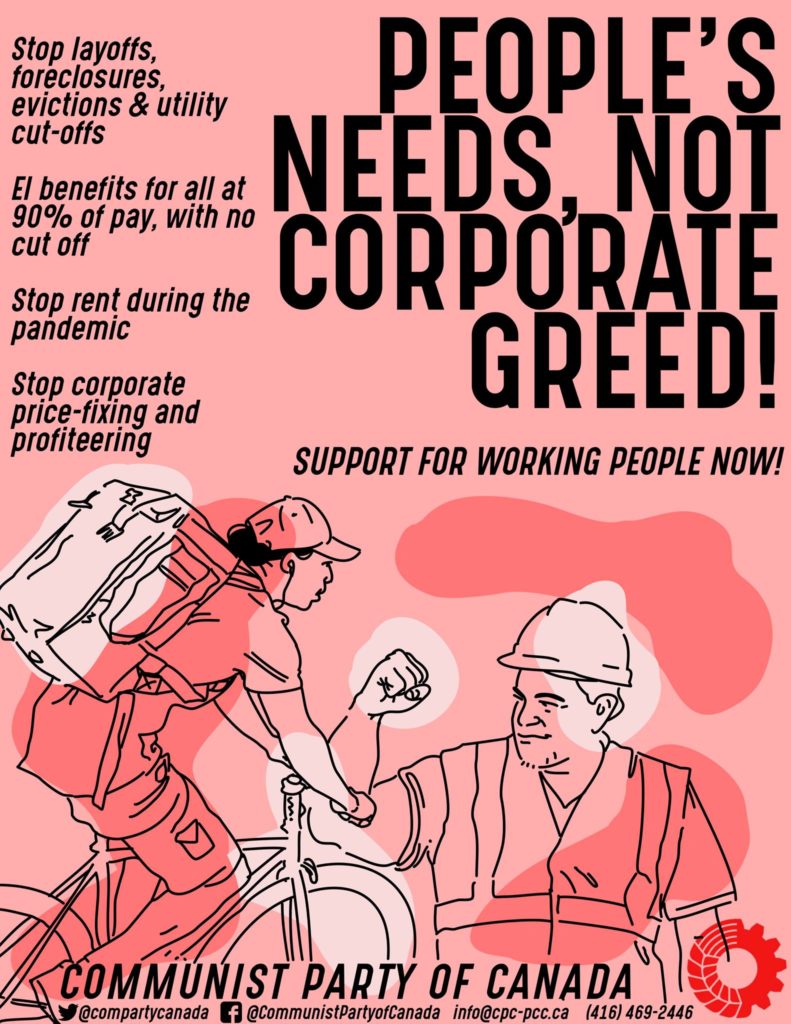
Those receiving social assistance (Ontario Works and Ontario Disability Support) do not qualify for CERB, except for those who were working part-time, lost their jobs due to COVID-19 and who meet the other eligibility requirements. However, the Ontario government will claw back half of the CERB to those on social assistance.
Provinces across Canada have offered token amounts as emergency top-ups to those on social assistance. The Ontario government has done even less than some other provinces with a monthly emergency benefit payment of only $100 per individual, and $200 for families living on OW or ODSP. While CERB itself is not a livable income for most, governments have shown that people with disabilities and those with the lowest incomes are an afterthought and that their rights to live with dignity are being denied.
The other major federal program is the Canada Emergency Wage Subsidy (CEWS) that allows businesses to claim 75% of wages paid to current and re-hired employees until the end of August. This is a subsidy directly to businesses with most of it going to the largest employers (big business). There are no guarantees that the Canada Emergency Wage Subsidy (CEWS) funds will be transferred in full to workers, as the PM has stated that the government is working with corporations on the basis of “trust”.
The Federal Government has provided almost $40 billion to financial institutions to advance interest free loans to small businesses. These loans are being offered to businesses who already have debt portfolios with the banks, making it clear that those who are in high and urgent need are excluded from all kinds of relief.
Small and medium sized businesses and self-employed individuals are at high risk of closure. They are only offered deferred deadlines for filing and remitting HST and taxes.
Clearly, we need a fundamentally different way forward that necessitates a clean break with corporate power. Jobs can be protected and built through massive investments in healthcare, emergency expansion in public health, and the transfer to public ownership and expansion of the pharmaceutical industry and medical equipment manufacturing.
The burden of the crisis cannot be put on the shoulders of working people with the least ability to pay. The labour and peoples’ movements are at a crossroads: people before profit. Or profit before people.
The Communist Party of Canada (Ontario) demands:
• convert Canada’s $25 billion military budget to civilian spending for public healthcare, hospitals, beds, staff and equipment, medical research, testing for COVID-19, and for protection of workers’ jobs, wages and incomes, the sick, the elderly, and the poor;
• make EI non-contributory, and universal and immediately accessible to all workers including part-time and precarious workers and first-time job seekers, for the duration of unemployment at 90% of previous wages or 90% of an annual livable income;
• introduce a guaranteed livable income program, to raise social assistance and disability payments to a living level well above the poverty line;
• eliminate student debt, cancel credit card debt and defer other personal debts, including mortgages and loans;
• loans to businesses must not be the publicly funded corporate bailouts of the 2008-09 economic meltdown. Public funding must buy public equity (a public share of the business), or public ownership where it is in the public interest to do so (e.g. energy, banking, transportation);
• the phasing out of fossil fuels and the rapid transition to a publicly owned and delivered renewable energy industry, as a part of a comprehensive just transition for workers and affected communities;
• enact progressive tax reform based on ability to pay, to shift the tax burden onto corporations and the very rich.
The political situation in Ontario
As working people suffer in the midst of a massive public health and economic crisis, the corporate media and politicians representing big business from various political parties have united behind the Ford government.
Before the current crisis Doug Ford’s approval rating had dropped to around 30%. In a December 2019 poll, Ford ranked last in popularity of all premiers in Canada. Since mid-March, there have been countless articles congratulating Premier Ford on his “handling” of the crisis.
Ford’s presentation may look professional and sound sincere to corporate political commentators. His policies, however, are still biased against the working class.
Single day increases in COVID-19 cases continue to hover close to their peak without clear signs of dropping. Quebec, Ontario, and Alberta are the three provinces that are doing the worst to contain the spread. The long-term care crisis has been raging for weeks and now over three hundred cases have been announced in shelters and prisons are reporting outbreaks. So, where is the success in “handling” the crisis that Ford is being applauded for?
The reality is that Doug Ford, his government, and his class, all did their best to deepen the crisis in Ontario. Since becoming Premier in 2018, he has carried out the most aggressive austerity agenda since the last Conservative government of Mike Harris in the mid-90s, except these days there’s even less left to cut. The hollowing out of social services and expansion of exploitation has drastically increased the vulnerability of Ontario and has increased the death toll.
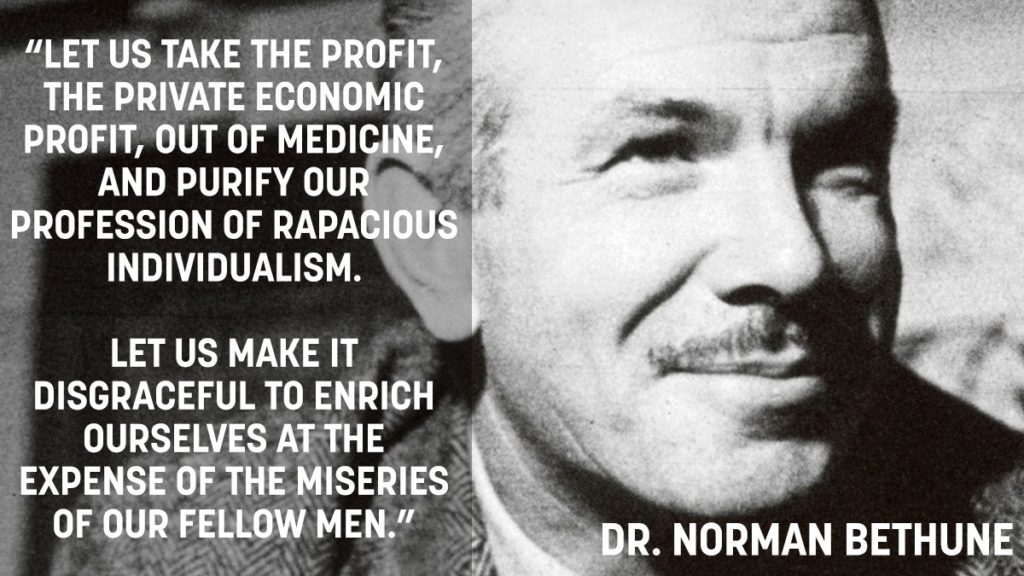
Healthcare
Among the Ford government’s massive cuts in the 2019 budget, healthcare took the hardest hit. The current 18.3-hour hospital bed wait time is up sharply from 14.4 hours when the Conservatives were elected. This is a 27% increase. There was not a substantial shift in policy in funding after the pandemic struck. The new emergency funding of $3.3 billion for healthcare in Ontario due to COVID-19 is a 5 per cent increase. This amount is merely what the Ontario Health Coalition and other public healthcare advocates have been pushing for long before this crisis to meet population growth, aging and inflation. The emergency funding keeps the system afloat at the current levels, which are already inadequate with hospitals at overcapacity for the last several years.
The Communist Party of Canada (Ontario) demands:
• the immediate restoration of health and hospital funding with increases above the national average moving towards needs-based funding for healthcare;
• reverse the privatization of healthcare and take profit out of all aspects of health by expanding universal healthcare to include dental care, vision care, pharmacare, mental health and long-term care.
Long-term care
The pandemic currently gripping Ontario has exposed the precarious conditions for senior residents who live in long-term care (LTC) homes in Ontario. Over 60 per cent of the deaths from the COVID-19 in Ontario have been seniors who live in these homes. Out of a total of 626 long-term care homes in Ontario, there have been outbreaks (defined as two or more reported cases) in 295 and this number grows every day. Over 4800 residents in these homes have tested positive for the corona virus, as have over 1600 staff, four of whom have died. Women comprise over 56 per cent of the total cases – their reward for outliving men and being the majority population in long-term care homes. (Statistics from Public Health Ontario – May 24, 2020).
The Conservative government has said that long-term care in Ontario “needs to change” in light of the glaring vulnerabilities that are now exposed. However, the Ford government has been a proponent of deregulation and further privatization in the sector. Ontario has the highest proportion of for-profit nursing homes in Canada, with fifty-eight percent of them being privately owned. Extendicare owns thirty-four homes and manages forty-two others. The company earned $18.8 million in profits from its long-term care business across Canada in 2018. Tim Lukenda, the outgoing CEO of Extendicare, earned $5.1 million in 2018. Chartwell’s CEO, Brent Binions, earned $2.5 million in 2018 while his company posted $18.5 million in profits. The current Chair of the Chartwell Board is none other than former Premier Mike Harris, who made $237,000 in 2019, while workers at their homes made minimum wage.
The Ontario Progressive Conservatives received $340,477 in political donations from for-profit long-term care corporations in the decade leading up to Ford’s election. The Ford government cut inspections drastically. While there were over 600 full inspections done in 2017, half that number were done in the 2018 and only nine were completed last year. During the pandemic, inspections that follow up from complaints are done over the phone – in conversations with management.
New reports show that for-profit LTC deaths are far higher than non-profit and city run homes. The Toronto Star has reported that for-profit homes have four times as many COVID-19 deaths as city-run homes. Profits in privatized long-term care homes have been amassed from the commodification of the care for our parents and grandparents who, along with their caregivers, have been left in inhumane conditions, exposed and unprotected.
Before the pandemic hit, there were not enough staff in the homes to meet the needs of residents. The majority of staff who do the direct work with the residents – bathing, feeding, toileting, dressing – are Personal Support Workers (PSWs). These workers are often assigned to the private homes, along with Registered Nurses and Registered Practical Nurses, by temporary employment agencies and often work in more than one home. The average wage of a PSW is $16.50 per hour, which is just marginally higher than minimum wage. LTC staff are also not afforded the proper and safe protective equipment to wear to ensure that they would not be infected themselves or pass on the infection from resident to resident.
All this has shown the deadly effect of for-profit healthcare delivery. The revolving door between the for-profit LTC industry and government demonstrates the need to make a break with the parties of Big Business who are owned by these monopolies.
The Ford government has called for a commission into long-term care, but has said that public ownership over the entirety of this healthcare sector is off the table. There have already been plenty of reports written about the problems in long-term care with many of the same recommendations. The root of the problem is private ownership. An independent inquiry, free from the control of the government and long-term care owners and operators could uncover exactly who is responsible for which decisions that led to the crisis and who may be charged criminally. More broadly, an independent public inquiry is necessary into the government’s overall response to the pandemic. However, the immediate need to bring LTC under public ownership and democratic control can’t wait, and neither can enacting the recommendations of previous reports and inquiries.

The Communist Party of Canada (Ontario) demands:
• Take-over private, for-profit long-term care homes and expand the funding to allow for compassionate and humane standards of care for their residents;
• ensure that all staff in long-term care facilities be given proper PPE, including N95 masks and that all staff have comprehensive training in the use of PPE;
• issue an order for all residents and staff in long-term care be tested regularly for the COVID-19;
• carry out comprehensive inspections in all LTC homes;
• expand funding to:
o increase the salaries of LTC workers
o consolidate part-time positions to full-time
o provide all additional resources needed to halt the COVID-19 outbreak in LTC homes.
Personal Protective Equipment
Ontario has one of the highest rates of health-care worker infection worldwide. Healthcare workers account for over 4400 of the total reported cases – 17 per cent of the infected population – that’s one out of every six cases. The rate of infection would be much less with better policies, enough PPE and other supports. The Ford government has failed on all fronts.
Ford has gained glowing reviews in the media for calling out Trump for blocking Personal Protective Equipment (PPE) shipments and for helping to personally move boxes of PPE produced in Markham. However, there is still a massive shortage of PPE amongst front-line health care workers. In late April, the Ontario government intervened in court to try and block the Ontario Nurses Association from winning access to PPE for their members in long-term care homes. While the government is saying that different sectors of healthcare workers do not need N95 masks, there is growing evidence that necessitates the use of N95 respirator masks.
The dire situation around PPE did not just materialize unexpectedly this year. The shortage of equipment is one aspect of the overall underfunding and privatization of the public health care system over several decades. Fifty-five million N95 masks were stockpiled in Ontario, but they were allowed to expire rather than being replenished to keep the supplies up to date.
The Ontario and federal governments have put out voluntary calls to manufacturing companies to make ventilators and masks. Some businesses have stepped forward and signed agreements with governments. After a labour-led campaign in Oshawa, the federal government and General Motors announced that part of their mostly shuttered plant would begin manufacturing PPE. Fifty jobs were created for this purpose, but thousands are still out of work from GM’s layoffs last fall. And the more labour intensive, and more pressing need – the N95 masks – are not being manufactured at this plant. Much more can and must be done to meet the province’s health needs and create jobs.
The urgency and seriousness of the health crisis cannot rely on the good will of companies who are ultimately dependent on profits. We have already seen striking examples of how private interests are profiteering and price gouging, especially in the PPE and pharmaceutical industries. Decisive and direct action by the government must be taken to immediately produce necessities for the healthcare system and to create safe jobs in this essential industry.
Much of Ontario’s manufacturing base has been hollowed out by capitalist globalization and “free trade” agreements such as NAFTA/USMCA as corporations move their plants to low-wage, low-regulation jurisdictions. However, this crisis has revealed to all that this trend must be reversed.

The Communist Party of Canada (Ontario) demands:
• the public take-over and expansion of operations producing medical supplies and equipment;
• heavy penalties including jail time against theft or profiteering on the production and sale of medical supplies and equipment;
• pharmaceutical companies, long-term care corporations, producers of medical equipment and supplies, and others that are vital to public health should be put under public ownership and democratic control.
Housing
The emerging health and economic crises are compounding the already dire housing emergency in Ontario. Millions of Ontario residents who have seen reduced hours and incomes due to the escalating crisis are either unable to pay rent or are having to choose between paying landlords and keeping small sums for food and other emergency uses.
The housing emergency did not begin with the current crisis. It has been steadily escalating for years thanks to capitalism’s reliance on the real estate bubble, the unbridled greed of developers and landlords, and government collusion.
Ontario has seen a sharp rise in homelessness throughout the last decade. Shelters have been chronically overcrowded for years and have been pushed further past the breaking point due to the pandemic. Indoor public spaces have been shuttered for health reasons and homeless people have even fewer supports than usual. The crisis has amplified the fact that housing is a health issue.
In Toronto, a shelter resident with COVID-19 died on May 8th, with another resident at another shelter dying on May 13th. Homeless advocates have recently filed a lawsuit against the city for not enforcing physical distancing guidelines. There are now almost 300 cases of COVID-19 in Toronto’s shelter system, but this does not include the unknown infection rate among the sizable homeless population who do not use the shelter system. Shelter support agencies have allowed the homeless to pitch tents on their property, and demanded that the City open hotels and university residences to house at least those who are infected. There have been minor successes but much more needs to be done.
The Ford government has implemented regressive housing reforms that will make living standards and conditions worse for millions in the province. After promising no changes to rent control during the election, the government then brought in legislation which ends rent control for all new rental units as part of its “Housing Supply Action Plan.” There is no limit for rent increases on these new units, and the plan will contribute to raising rents across the board.
We demand guaranteed funding for sufficient and safe emergency shelters to meet the needs of the more than 12,000 people who are homeless each night. Women’s shelters need to be expanded immediately as domestic violence becomes more dangerous as families are forced to remain under the same roof and since economic crises lead to more violence.
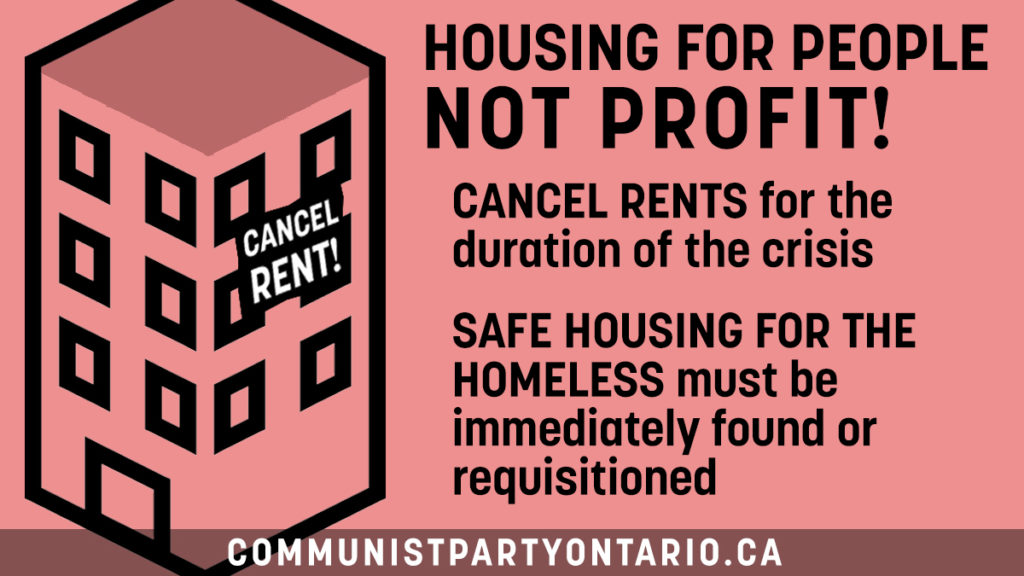
The Communist Party of Canada (Ontario) demands:
• the cancellation of rent payments for the duration of the crisis;
• the extension of Ontario’s temporary ban on evictions and ban foreclosures for two years;
• that safe housing be immediately found or requisitioned for the homeless, including the use of the Province’s expropriation powers, whether in hotels or in vacant units owned by Airbnb landlords and owners of speculation properties;
• the federal and provincial governments provide leadership and funding to address cities’ shelter crises and create systems where underhoused people can find temporary shelter with dignity;
• a comprehensive federal and provincial social housing program that treats housing as a public utility and delivers it according to need;
• close rent control loopholes (such as “renovictions” and the lack of control on new units) and bring in rent rollbacks for all renters in Ontario so that no one is compelled to pay more than 20% of household income for rent.
Labour
Workers in Ontario are facing mass layoffs, the reduction of hours and incomes, the rapid introduction of online technology leaving workers open to new forms of exploitation, unsafe working conditions with inadequate protective equipment, and low wages.
According to government labour market reports, 3 million workers have been laid off in March and April across Canada with one million of those in Ontario. 2.5 million have had their hours cut significantly since February in Canada. The official unemployment rate went from 5.5 per cent to 13 per cent in a two-month period, which is far beyond anything seen during the economic crises in 2009 or 1982. The fact that 8 million people have applied for CERB suggests that the situation could be even worse than these official figures suggest and that the only previous economic crisis that may compare is the Great Depression of 1929.
Low-pay and precarious jobs took the brunt of the job losses with a 16 per cent reduction in jobs in March for workers earning two-thirds or less of the median hourly wage. People working in higher paying jobs in office and administration are more likely to be able to work from home and continue to do so to some degree. The figures for young workers are staggering. Since February, official youth unemployment has gone from 10.3 per cent to a record of 27.2 per cent across Canada.
Much has been said about the importance of “essential workers” and a massive outpouring of gratitude has been shown towards these workers by other workers in Ontario, but also by governments and corporations. It is the governments and corporations who are hypocritically thanking these workers while keeping them at low rates of pay and failing to provide safe workplaces to stop the spread of the corona virus.
One of the Ford government’s “solutions” to this was to subsidize a temporary pay increase of $4/hr to frontline workers in three sectors – healthcare, long-term care, social services and prisons. However, important workers in these sectors – paramedics, dietary aids, ward clerks etc. were excluded. CUPE and other unions in the healthcare sector have taken on the fight for workers in these classifications.

Essential workers in other sectors also have a high risk of being exposed to COVID-19. This includes grocery, beer and liquor store workers, cleaners, transit workers and taxi drivers. With the higher risk comes fatal statistics – there have been 10 taxi drivers working out of Toronto’s Pearson airport who have died after testing positive. Taxi and limousine workers are majority racialized and new immigrant workers.
Workers in the food industry have been shown to be at significant risk. In early May, a worker at Maple Lodge Farm’s poultry processing plant in Brampton died and 25 tested positive. It was discovered that the company took three weeks to disclose a positive case. In late April, 47 workers at Greenhill Produce in Chatham-Kent, mainly migrant workers, tested positive for COVID-19. Inadequate, cramped and unhygienic housing caused the rapid spread of infection amongst migrant workers. In the food manufacturing and agricultural sectors, workers are disproportionately racialized with agri-business relying on Canada’s racist foreign worker programs to ensure exploitable and disposable skilled labour.
There have been some pay increases to help ensure that workers still come to work despite fearing for their lives. Maple Leaf Foods, who have massive poultry plants in Ontario have topped up paycheques with a measly $80 a week, despite a 12.8 per cent increase in sales revenue in the first quarter of 2020. Maple Leaf’s CEO has a net worth of $4.15 billion.
Loblaws has increased wages by $2/hr. Loblaws is owned by the third richest family in Canada, the Westons, with a net worth of $7 billion. Galen Weston, the CEO of Loblaws has played an important role in lobbying against raising the minimum wage to $15/hr in Ontario.
These corporations are doing the bare minimum to ensure a continuation of low-pay and precarious labour power, even while their profits are increasing in the current conditions. Much more is needed in terms of pay and safety, which will only come from the workers, organized labour and the public standing with essential workers and fighting for more.
Workers have been speaking out and fighting to win the living and working conditions necessary for their safety. Workers had filed 213 work refusals by the end of April. In mid-March there were 83 work stoppages in a single week, whereas the usual average is 4 per week from earlier in the year. The Ontario Ministry of Labour has not upheld a single refusal, saying that they did not meet their criteria for a legitimate work stoppage.
The Ministry is operating under new guidelines to ensure that work stoppages are ignored. The Ministry of Labour has set up an internal body, at first named the “Work Refusal Advisory Committee”, now the more broadly named “COVID-19 Advisory Team.” Reports and orders issued by health and safety inspectors must be sent to the “lawyers and managers” who make up the committee. Inspectors, the people who go into the workplaces, are now overseen by new management. It is clear that the government is ensuring that business can operate freely to ignore workers’ safety concerns.
It should be noted that record work stoppages point to a much bigger problem. Many fear that exercising their right to refuse unsafe work will result in reprisals and healthcare workers can only refuse unsafe work if it will not endanger someone in their care.
With efforts underway in Ontario to speed up the re-opening of more stores and workplaces, health and safety struggles will only become more widespread and urgent. It is clear that the Ford government is managing the situation to benefit the largest monopolies in the province at the expense of workers’ wages and health.
Large numbers of other workers not on the frontlines are also facing new challenges. 3.3 million workers across Canada saw major changes in their work as they started working from home since March. The introduction of new technologies threatens permanent automation, job loss, expanding precarious work and declining quality of service. For example. in education major struggles have been waged against shifting to online learning in both public and post-secondary education. We have every reason to believe that the government and private education providers will try and use the new online infrastructures developed due to the pandemic to cut jobs and lower the quality of education.
The Communist Party of Canada (Ontario) demands:
• guarantee all workers 21 paid sick days;
• enforce COVID-19 health advisories in workplaces, with penalties for employers who violate the advisories; set-up hotlines to report employer violations;
• enforce the right of all workers – organized and unorganized – to refuse unsafe work;
• raise the minimum wage to a livable wage of $20/hr, this would raise the floor on all wages in the Province;
• introduce plant closure legislation to stop unjustified runaways, closures and layoffs;
• that the Ontario Federation of Labour call for a solidarity conference to begin to set the ground for mass action on a program of fighting for worker’s rights post-pandemic.
Women
The pandemic is having a profound impact on women and racialized workers, who make up the majority of healthcare and other front-line workers. Statistics Canada data from 2018 indicate that women comprise 82 per cent of health workers in Canada, nearly 10 per cent higher than the global rate of 75 per cent. In addition, women have to look after their children while daycares and schools are closed, some who juggle working from home, supervising on-line teachings and ensuring their children are safe.
Statscan pointed to a striking gender divide in job losses in March. Women between 25 and 54, who are more likely to have school-age children, lost more than twice the jobs (298,500) as men in the same age cohort (127,600). Almost twenty per cent of employed women in that age bracket lost all or the majority of their usual work hours in March, compared with 13.9 per cent of similarly aged men. The disproportionate impact of the economic crisis on women is rooted in the gendered division of labour.
During the pandemic, childcare centres were closed across the province and the government ruled that they could not collect parent fees while the centres were closed. Many centres now face bankruptcy as they are not able to afford the rent that is accruing during the months of closure. The government must address this crisis to ensure all existing daycares remain solvent. In addition, the province needs to fund more not-for-profit, accessible and affordable childcare centres in order to facilitate the return to work for everyone.
As the pandemic has spread, the issue of violence against women has become even more widespread. Women’s shelters, already turning women away before the crisis, are overwhelmed. The high cost of housing is another huge barrier for women and their children to escape violence.
The need for comprehensive action towards full gender equality is clear.
The Communist Party of Canada (Ontario) demands:
• restore funding for women’s equality programs;
• close the wage gap – legislate full pay and employment equity;
• guarantee accessible and publicly funded abortion and reproductive rights services in every province and territory;
• create a universal, accessible, affordable, quality, public childcare system, with Canada-wide standards and union wages for childcare workers;
• protect women’s right to EI maternity coverage; expand parental benefits to 52 weeks;
• end the attacks on trans women and defend their rights;
• end all forms of violence against women and provide adequate funding for crisis centres and transition houses;
• repeal Harper’s Bill C-36, which effectively criminalized sex workers.
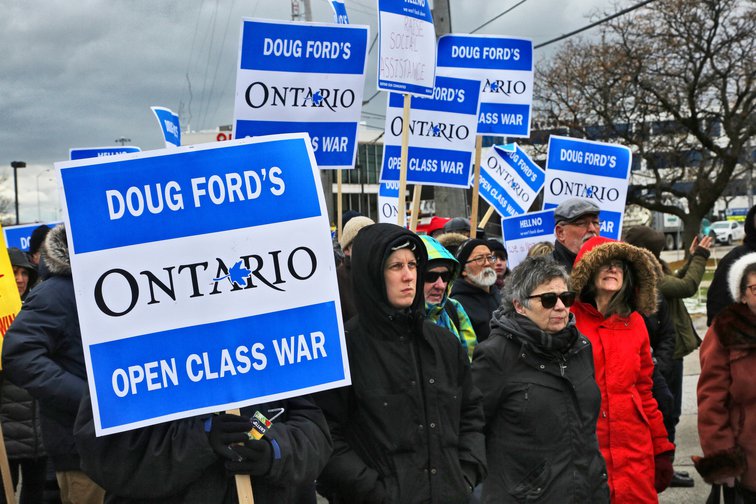
A new wave of austerity to come
Overall, the Ford government represents the most aggressive sections of capital in the province. They are quite clear in what they want: lower taxes on corporations and the wealthy and the defunding and privatization of social services, health and education. The less the government taxes and spends, the better for their profits, and the worse for workers’ social wages and the most vulnerable sections of the population.
We have already seen this clearly in the last two years. Massive spending cuts across the board have been justified by lies and distortions about the government deficit. However, the massive cuts that were implemented were not being used to pay down Ontario’s relatively modest deficit but to cut revenue instead. Tax cuts brought in by the Ford government were already costing $4.2 billion in 2019-20, with more tax cuts pending. When you compare the cost of tax cuts to the cost of nominal spending increases planned for the next three years, tax cuts accounted for 60% compared with 20% for health and 2% for education.
To keep pace with population growth and inflation, without cutting already inadequate services, the province would need to spend $11.4 billion more in the next three years, less money than the Ford government was planning to spend on tax cuts.
The current health crisis will not last forever. Politicians, including Ford, pepper their speeches with hopeful messages about the future. However, the Ford government is not being honest about the depth of the capitalist economic crisis that was triggered by the pandemic. On March 25th, the Ford government released their Fiscal Update. It was based on the overly optimistic assumptions that COVID-19 will have a minimal effect on government revenues from personal income and business taxes. It shows that Ontario’s low unemployment rate will not significantly rise this year and that Ontario will be back to growth in the second half of the year. Meanwhile the IMF is predicting the worst downturn since the Great Depression.
How will the Ontario government handle the economic crisis that we are only just starting to feel? It is clear that the Conservative government will not make a sharp break from corporate austerity policies. It will double down on austerity to ensure that working people pay to recover corporate profitability. There are major struggles ahead to fight for a people’s recovery.
Limited opposition in Queen’s Park
The opposition parties are not focused on the big picture corporate agenda of the Ford government, and there is no clear working-class perspective being consistently represented inside the legislature. Andrea Horwath and the Ontario New Democrats have adopted a “play-it-safe” strategy that celebrates their substantial seat increase in 2018. They are playing the “government in waiting” until 2022, and worse still, some in the labour and people’s movements have been convinced that they just need to wait another two years in order to win a “progressive government.”

While the ONDP has spoken up on access to PPE and against the privatization of health care in general, the New Democrats are not offering an alternative program that challenges the power of corporations. For example, they have chosen not to call for a cancellation of rents. After six weeks of crisis in long-term care, the ONDP have called for a public inquiry and an “evaluation of the continuing role of for-profit homes.”
With the NDP trying to avoid rocking the boat, it is no wonder that the Liberal Party has seen a resurgence buoyed by the Liberals continued support from sections of big business. Two by-election victories and the recruitment of former Tory MP Amanda Simard have also helped the Liberals. Despite the NDP having 40 seats to the Liberal’s 8, the Liberal Party lead a poll at the beginning of 2020 with 33 per cent support, as opposed to the Conservative’s 29 per cent, and the NDP’s 27 per cent (down 7 per cent since the election in 2018).
Working people in Ontario should not be confused by a rebranded Liberal Party under their newly elected leader. Steven Del Duca is a career Liberal, an aide to McGuinty and a Minister under Wynne. We can only expect continuity from the Liberal Party as the same party that did not live up to their promise of reversing most of the cuts of the Harris years and instead enforced fifteen years of austerity through a slow boil strategy. The austerity-by-attrition approach of the Liberals may seem preferable to the Conservative slash-and-burn strategy of the current government; however the working class can afford neither and a sharp break with corporate power is necessary to address the deep capitalist crises we are currently facing.
A duck-and-cover approach by labour and people’s movements that waits for the self-destruction of the Ford government before the next election, will likely result in the election of the Liberal Party again, or possibly the Ontario Progressive Conservatives who continue to fundraise vast amounts of money. Even if the ONDP were able to win, their weak reformist proposals will not address the deep capitalist crises we are currently facing. It is clear that labour and people’s movements cannot afford to wait for the next election.
The fightback in Ontario
What is the response from labour in the face of an unprecedented wave of unemployment and the attacks on health and safety legislation and regulation? The Canadian Labour Congress issued a joint statement with the Canadian Chamber of Commerce that solidified its tri-partisim:
“The Canadian Chamber of Commerce and the CLC will be united in our efforts to ensure that every sector of the economy receives all necessary stabilizing support. Furthermore, we will develop complimentary policy options to help governments implement timely and meaningful programs to support Canadians through this period.
At every turn, we will be looking to work collaboratively and assist all levels of government to ensure response programs reach those who need support in a timely and effective manner.”
Thankfully, individual affiliates have not swallowed the same pill. CUPE has organized weekly meetings with its healthcare members and has developed campaigns to pressure the government on PPE, pay increases and staffing. SEIU has demonstrated support for its members with car cavalcades. The Ontario Nurses Association, Unifor and OPSEU also represent workers in the healthcare sector and have all spoken out against government inaction.
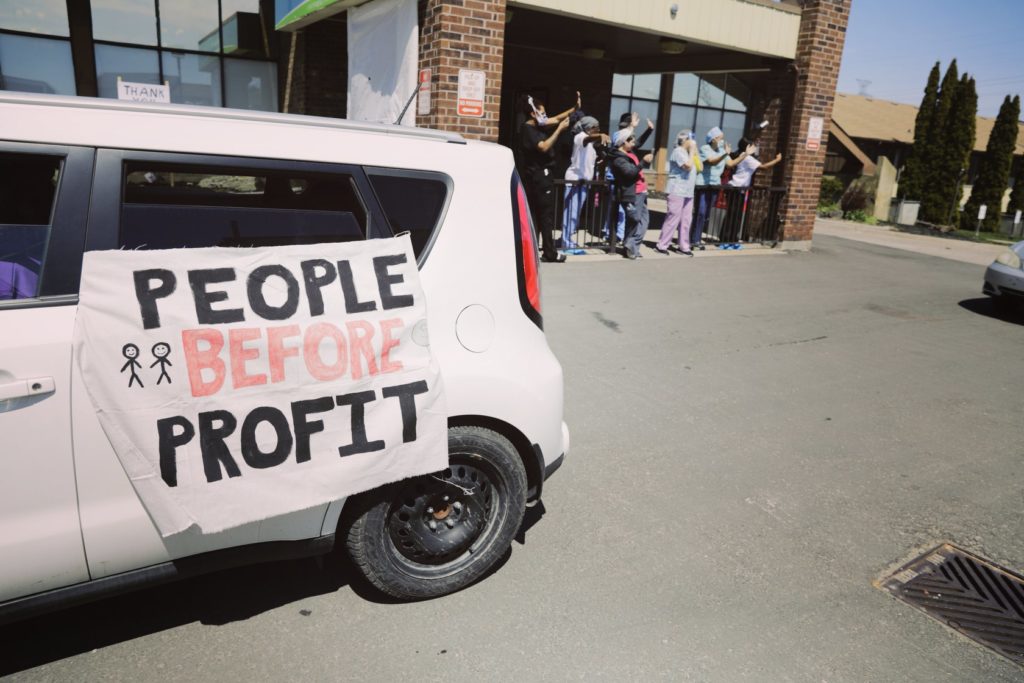
The rise in unsafe work stoppages show that many workers are ready to take immediate action. This includes a work refusal in April of TTC bus drivers, backed by their union, who cited mask scarcity and other safety concerns. Of course, the Ministry did not uphold their refusal. There is an immediate need for organized solidarity and leadership from labour councils and labour federations to bring these workplace battles together towards meaningful province-wide improvements to working conditions.
The Ontario Federation of Labour has been active in the GM retooling fight in Oshawa, but needs to step up the action in organizing a coordinated fightback to stand up to the mismanagement of the current crisis and be ready for the onset of austerity policies once this pandemic is over.
A stronger Action Caucus movement at all levels of labour can play a decisive role in the current movement to unite the left, win the centre and isolate the right in order to win a program of escalating action which includes the political strike weapon.
There are other signs of fightback emerging as well. Migrant workers and migrant rights organizations have stepped up their actions and demands in order to protect their health, livelihoods and rights.
The Ontario Health Coalition, which our Party and many unions and local coalitions belong to, have done an excellent job in researching what is going on in the healthcare sector. We need to step up our efforts to support the OHC and local coalitions as the fight for public universal healthcare is as important now as ever before.
A rent strike movement has been growing in North America including Ontario. Some cities have tenant groups that are helping to build the necessary organizational infrastructure of a successful rent strike. In Toronto, organizers are putting tenants in touch with each other if they are in the same neighbourhood or building. Parkdale Organize, the group that helped organize the successful rent strikes in Parkdale in the recent past, have set up an important network of tenants that are organizing online under the campaign “Keep Your Rent.” This has been successful in some buildings. As more and more tenants have trouble keeping up with rent, the political campaign to cancel rents and take meaningful action to end the housing crisis will only become more important.
As labour and people’s movements search for new tactics to ramp up the fightback, the Communist Party will be there to help build and connect struggles towards fundamental change.

Political Report amended and adopted at the May 16, 2020 meeting of the Provincial Committee, Communist Party of Canada (Ontario)

